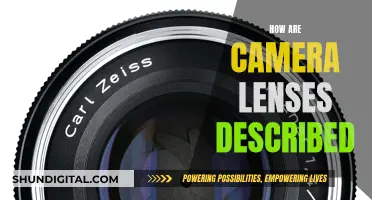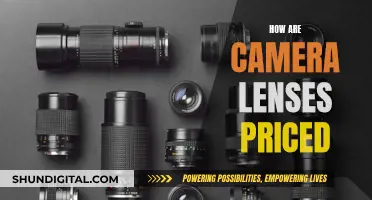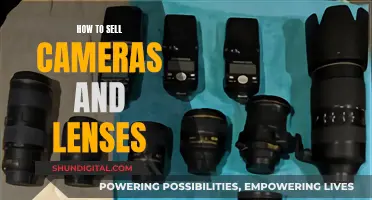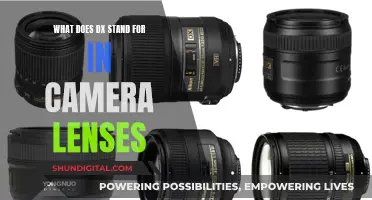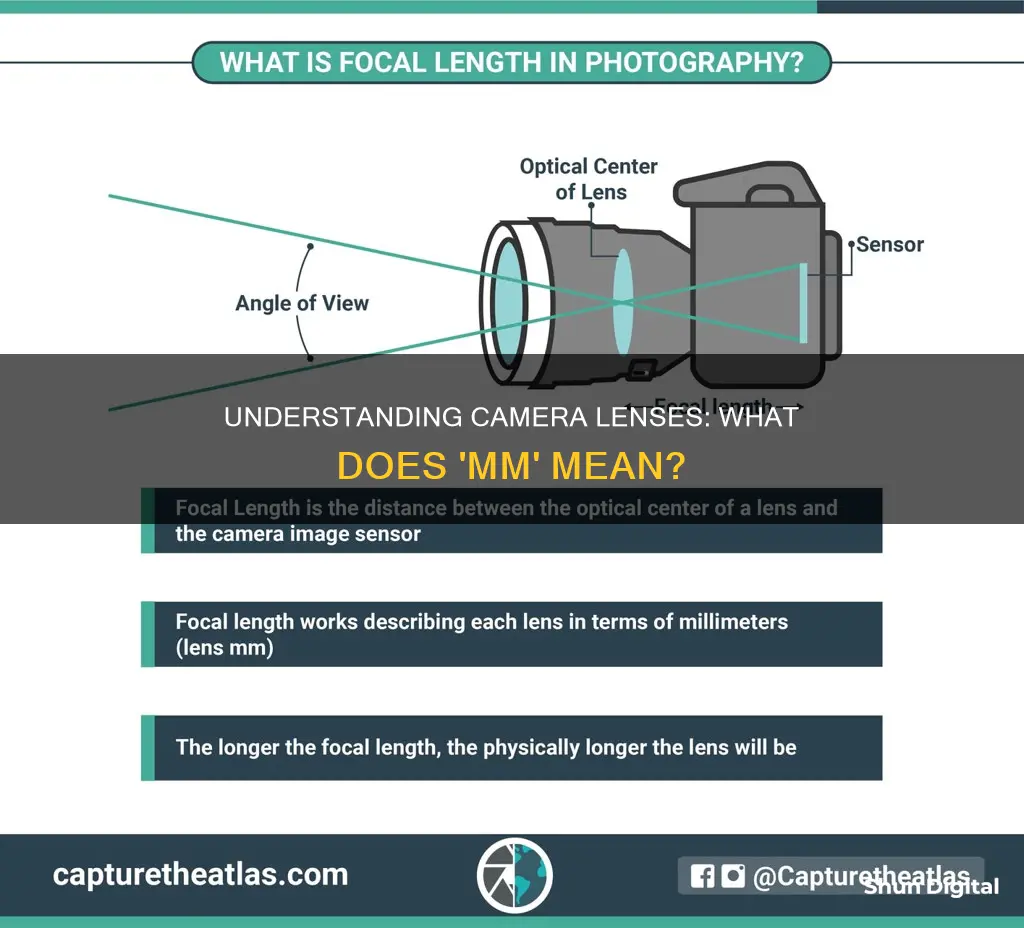
The 'mm' number on a camera lens is a measurement in millimetres of the focal length. This measurement is taken from the optical centre of the lens to the camera's sensor when focused on infinity. The focal length of a lens is determined when the lens is focused at infinity. The lower the focal length, the more you will see in your image (wider view). The higher the focal length, the less you will see in your image (more zoomed in).
| Characteristics | Values |
|---|---|
| What does mm stand for? | Millimetres |
| What is it? | The focal length of a lens |
| What does it tell us about a lens? | How much of a scene you can see when looking through it |
| How is it calculated? | The distance from the centre of the lens to the image focal point |
| What is the focal length? | The angle of view and the magnification |
| What is the focal length of a lens determined by? | When the lens is focused at infinity |
| What is the difference between a wide-angle lens and a telephoto lens? | A wide-angle lens has a short focal length, whereas a telephoto lens has a long focal length |
| What is the difference in terms of the angle of view? | A wide-angle lens has a wide angle of view and a telephoto lens has a narrow angle of view |
| What is the difference in terms of magnification? | A wide-angle lens has lower magnification and a telephoto lens has higher magnification |
What You'll Learn

Focal length
The focal length of a lens dictates whether you will capture a wide vista or a close-up of a distant subject. Lenses with a focal length shorter than 50mm are known as wide-angle lenses, capturing a broader field of view, which is ideal for landscapes, architecture, and other situations requiring a wide-angle perspective. Conversely, lenses with a focal length greater than 50mm are called telephoto lenses, capturing a narrower field of view, which is useful for portraits, sports photography, and any situation where you want to isolate the subject from the background.
It's important to note that the focal length of a lens is not the same as the physical length of the lens. Instead, it is a calculation of the optical distance from the point where light rays converge to form a sharp image on the sensor or film. This measurement is taken when the lens is focused at infinity.
There are two main types of lenses: prime lenses and zoom lenses. Prime lenses have a fixed focal length, meaning the perspective can only be changed by physically moving the camera closer or farther from the subject. Zoom lenses, on the other hand, offer variable focal lengths, providing the convenience of adjusting the zoom without having to change lenses.
Understanding focal length is essential for photographers as it helps them choose the right lens for their desired shot. It also impacts the depth of field, with longer focal lengths resulting in shallower depth of field, allowing for a softer or blurred background.
Camera Lenses: Tax Benefits and What Qualifies as 'Listed Property
You may want to see also

Field of view
The 'mm' number on a camera lens refers to the focal length, which is measured in millimetres. This is the distance from the optical centre of the lens to the camera's sensor when focused on infinity.
The focal length determines the field of view, or how much of a scene the camera will capture. A lower focal length (smaller number) will result in a wider view, while a higher focal length (larger number) will result in a more zoomed-in image. For example, a 17mm lens will capture a very wide scene, whereas a 200mm lens will be highly zoomed in, capturing only a small part of the scene.
Lenses with shorter focal lengths (less than 50mm) are known as wide-angle lenses. They are able to capture a wider field of view, making them useful for landscapes, architecture, or any situation where you want to capture as much of the scene as possible. Conversely, lenses with longer focal lengths (greater than 50mm) are called telephoto lenses. These lenses capture a narrower field of view, which is useful for portraits, sports, or any situation where you want to isolate the subject from the background.
It's important to note that the focal length isn't the only factor that determines the field of view. The size of the camera's image sensor also plays a role. For instance, on a camera with a smaller image sensor, such as an APS-C sensor, a 50mm lens would behave more like a telephoto lens because the smaller sensor crops the image and narrows the field of view.
The field of view can also be described as the angular field of view, which is the angle of view or "lens view". It can be specified in degrees and is calculated based on the focal length and sensor size.
Filters for Capturing Cinematic Shots with Your Camera Lenses
You may want to see also

Zoom
The zoom factor of a lens is the ratio between the longest and shortest focal lengths it can achieve. For example, a 100-400mm lens has a zoom factor of 4x. The higher the focal length number, the more "zoomed in" the lens will be.
The focal length of a lens is usually represented in millimetres (mm) and is a calculation of the optical distance from the point where light rays converge to form a sharp image of an object to the digital sensor or film at the focal plane in the camera. The focal length of a lens is determined when the lens is focused at infinity.
The longer the focal length, the narrower the angle of view and the higher the magnification. Conversely, the shorter the focal length, the wider the angle of view and the lower the magnification.
When choosing a zoom lens, it is important to consider the quality of the lens, as lower-quality lenses may result in distortions or aberrations in your images. Additionally, the intended use of the lens will also impact the cost, with lenses designed for professional use often being more expensive due to their weather sealing and advanced features.
Leica Lenses: Panasonic Cameras' Secret Weapon?
You may want to see also

Wide-angle lenses
A wide-angle lens is a lens with a short focal length and a wide field of view. This type of lens allows the camera to capture more of a scene than a normal lens, making it a popular choice for architectural, landscape, street, and travel photography. Wide-angle lenses are also used for establishing shots in film, emphasising camera movement, and creating a subjective perspective for the audience.
The focal length of a wide-angle lens is typically considered to be anything below 35mm, which is equivalent to a diagonal field of view of around 63 degrees. Lenses between 35mm and 24mm are considered standard wide-angle, while those below 24mm are considered ultra-wide-angle. The most popular wide-angle zoom range is 16-35mm.
When choosing a wide-angle lens, factors such as aperture, build quality, size, weight, image quality, and weather sealing should be considered, depending on the intended use. For example, a wide aperture (lower f-number) is advantageous for low-light conditions, while weather sealing is important for outdoor photography.
Some popular wide-angle lenses include the Canon RF 24mm F/1.8 Macro IS STM, Nikon NIKKOR Z 20mm F/1.8 S, Sony E 20mm F/2.8 SEL20F28, and the Canon EF 28mm f/1.8 USM.
Recognizing Sigma Camera Lenses: A Quick Guide to Identification
You may want to see also

Telephoto lenses
A telephoto lens is a long-focus lens with a focal length of 60mm or more. They are used to capture distant objects and give an enlarged image. The longer focal length means that telephoto lenses are great for bringing faraway subjects closer to the camera, emphasising blurred backgrounds, and taking portraits. They are also useful for landscape photography and sports photography.
When choosing a telephoto lens, it's important to consider your preferred type of photography and the compatibility of the lens with your camera body. It's also worth noting that the longer the focal length, the harder it is to keep the lens steady, so longer telephoto lenses may require a tripod to stabilise them.
Action Cameras: Fisheye Lenses and Their Uses
You may want to see also
Frequently asked questions
MM on a camera lens stands for millimetres.
The mm number on a lens is a measurement of the focal length in millimetres. The focal length is the distance from the centre of the lens to the image focal point or image sensor surface.
A wide-angle lens has a short focal length (under 50mm) and a wide angle of view. A telephoto lens has a long focal length (over 50mm) and a narrow angle of view.


